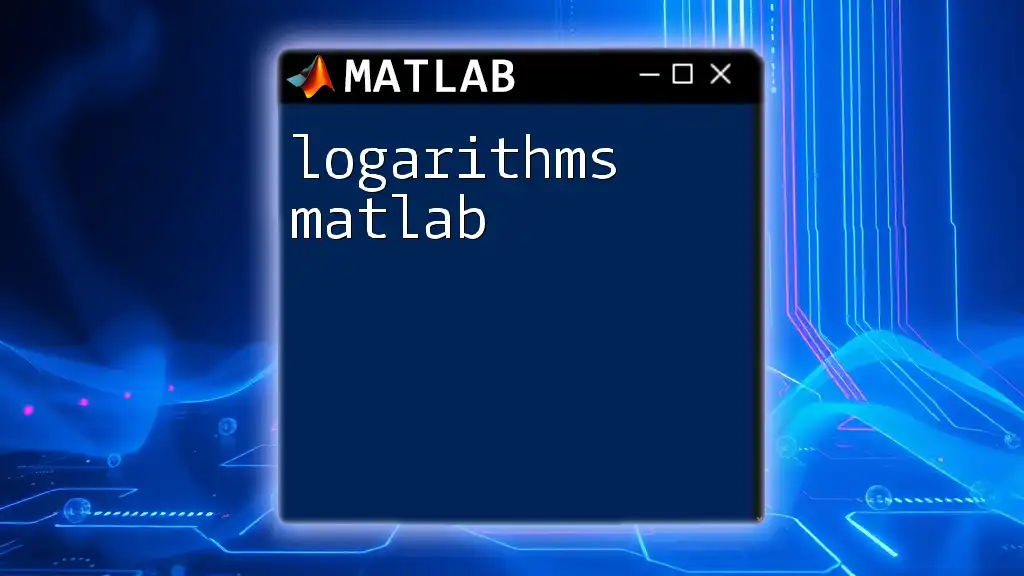The `fitdist` function in MATLAB is used to fit a probability distribution to data, allowing users to estimate parameters and assess the goodness of fit.
data = [1.2, 2.3, 2.9, 3.5, 4.8, 5.1]; % Sample data
pd = fitdist(data', 'Normal'); % Fit a normal distribution to the data
Understanding the Basics of Distribution Fitting
What is Distribution Fitting?
Distribution fitting is the process of selecting a statistical distribution that best describes a set of data. This is crucial because it allows statisticians and data analysts to make inferences about the data, predict future values, and assess the underlying processes that generate the data. By fitting a distribution, we can summarize the data with a mathematical model, which simplifies analysis and interpretation.
When to Use `fitdist`
The `fitdist` function in MATLAB is particularly useful when you have a dataset and you want to find the most appropriate probability distribution that characterizes the data. Use `fitdist` when you are dealing with continuous or discrete data and need to perform tasks like hypothesis testing, risk assessment, or to simply understand the variability in your data.

Getting Started with `fitdist`
Prerequisites
Before diving into using `fitdist`, it’s essential to have a solid grasp of MATLAB and a basic understanding of statistical concepts. Ensure you have the Statistics and Machine Learning Toolbox installed, as `fitdist` is part of this toolbox.
Syntax and Structure of `fitdist`
The basic syntax of the `fitdist` function is straightforward. It typically follows this structure:
pd = fitdist(data, 'DistributionName')
- data: This is your input dataset, which can be a vector or a matrix.
- DistributionName: This is a string that specifies which type of distribution you want to fit to your data, such as `'Normal'`, `'Exponential'`, or `'Lognormal'`.
For example, to fit a Normal distribution to a dataset:
pd = fitdist(data, 'Normal')

Types of Distributions Available
Commonly Used Distributions
`fitdist` supports various types of distributions that you can use for fitting your data. Here are a few commonly used options:
- Normal Distribution: Ideal for datasets that follow a bell-shaped curve. Used widely in finance and social sciences.
- Exponential Distribution: Commonly used for modeling time until an event occurs, like failure rates.
- Lognormal Distribution: Useful for data that cannot be negative and is positively skewed, such as income or stock prices.
- Weibull Distribution: Often applied in reliability analysis and survival studies.
For each distribution, `fitdist` provides relevant statistical properties that can be useful in your analysis.
Specifying Distribution Types
How to Specify Different Distributions
When using `fitdist`, specifying the distribution type is crucial. Each distribution has its strengths and is suited to different kinds of data. To fit a specific distribution, simply replace `'DistributionName'` with your chosen type when calling `fitdist`. Here’s how to fit multiple distributions:
pd1 = fitdist(data, 'Exponential');
pd2 = fitdist(data, 'Lognormal');
The results can be stored in different variable names (`pd1`, `pd2`) to facilitate comparison later.

Fitting the Data
Preparing Your Data
Data preparation is essential for obtaining reliable and accurate fitting results. Focus on cleaning your dataset—handle missing values appropriately by either removing them or imputing them. Outliers can significantly skew your fitting results, so it's advisable either to analyze them separately or to apply robust statistical techniques if they exist.
Fitting the Distribution
Once your data is cleaned, you can fit the distribution. It generally involves a few simple commands in MATLAB. For example, if you have a dataset generated from a Normal distribution, the code to fit it would look like this:
data = randn(1000,1); % Example data
pd = fitdist(data, 'Normal');
This command fits a Normal distribution to a set of 1000 random numbers drawn from a standard normal distribution.
Evaluating the Fit
Goodness-of-Fit Tests
After fitting the distribution, it's essential to evaluate how well it fits your data. Goodness-of-fit tests provide this insight. Common methods include the Chi-square test or the Kolmogorov-Smirnov (KS) test.
For example, using a Chi-square test, you can evaluate the fit as follows:
[h, p] = chi2gof(data, 'CDF', @(x) pd.cdf(x));
Where `h` indicates whether the null hypothesis (that the data is well-represented by the fitted distribution) is rejected, and `p` represents the p-value.

Visualizing the Fit
Plotting the Fitted Distribution
Visualization is an integral part of understanding your fit. The Probability Density Function (PDF) and Cumulative Distribution Function (CDF) provide graphical representations of your fitted distribution. Use the following code snippet to visualize the fitted Normal distribution alongside your data histogram:
x_values = linspace(min(data), max(data), 100);
y_values = pdf(pd, x_values);
plot(x_values, y_values);
hold on;
histogram(data, 'Normalization', 'pdf');
legend('Fitted PDF', 'Data Histogram');
Interpreting the Plots
Understanding your plots is crucial. A good fit will display a histogram that aligns closely with the fitted PDF. Discrepancies may indicate that the chosen distribution does not adequately capture the data characteristics.

Advanced Features of `fitdist`
Custom Distributions
In more advanced applications, you might need to fit custom distributions to your data. MATLAB allows this flexibility with the following syntax:
pd_custom = fitdist(data, 'DistributionName', 'ParameterName', ParameterValue);
This enables you to specify additional parameters based on your unique distribution requirements.
Multiple Distributions Comparison
Sometimes, you may want to compare how different distributions fit your data. You can do this by fitting multiple distributions and plotting their PDFs or comparing their goodness-of-fit metrics.
pd1 = fitdist(data1, 'Normal');
pd2 = fitdist(data2, 'Exponential');
This sets the stage for visual and statistical comparison of how well each distribution models your datasets.

Common Issues and Troubleshooting
Potential Errors with `fitdist`
While using `fitdist`, errors can arise, especially if the data is not suitable for the chosen distribution or if there are not enough data points. Common problems include incompatible data shapes, missing values, or very low variances.
FAQs
Addressing typical questions can clarify usage:
- What happens if I don't have enough data?: The model may not converge or yield unreliable estimates.
- Can I fit more than one distribution?: Yes, you can fit multiple distributions and compare their fits using goodness-of-fit tests.

Conclusion
In summary, the `fitdist` function in MATLAB provides an efficient and robust methodology for fitting probability distributions to data. By understanding its syntax, evaluating the goodness of fits, and visualizing the results, you can draw meaningful statistical insights.
Encourage readers to practice with real datasets to solidify their understanding. Exploring different distributions and their fitting can reveal profound insights into data behavior, enabling more informed decision-making.

Resources
For further exploration, consider visiting the official MATLAB documentation on `fitdist` and additional tutorials that delve into advanced statistical modeling techniques.

Further Learning
I recommend exploring online courses or content dedicated to MATLAB for a deeper dive into both basic and advanced statistical techniques, enhancing your proficiency with this powerful language.

















